Psoriasis (translated from the Greek "psora" - "skin disease, scabs") is a chronic pathology of a non-infectious nature, also known as scaly lichen, which mainly affects the skin of the knee and joints of the elbow, lower back and head. There is also psoriasis of the joints, bones, nails, external genitals and internal organs, but these forms are rarely diagnosed. The pathology is difficult to cure, so when the first symptoms appear, red skin rashes, an urgent need to see a doctor.
Symptoms
Stearin stain
The first sign of psoriasis, which is part of the triad of symptoms of the pathology. It is characterized by increased peeling after scraping the affected surface with a spatula. Over time, there is a separation of the whites of silvery-white scales. Its removal is not difficult, since they are loose and adhere weakly to the psoriatic papule. The surface of the neoplasms (eruptions) turns white and the particles disintegrate and resemble shavings.
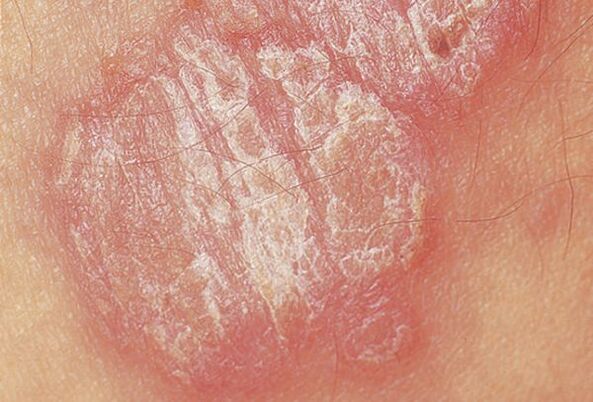
The first phenomenon of the triad is explained by the development of parakeratosis (improper functioning of the epithelium, which leads to the violation of the formation of the stratum corneum). To combat deviations in the initial phase, local non-hormonal agents (creams, ointments) are used.
Terminal Film
It is characterized by the removal of a thin layer of tissue from the papules, which has a shiny structure and resembles polyethylene. It is easily separated by any impact (pressure, friction, etc. ) after removing the dry flakes.
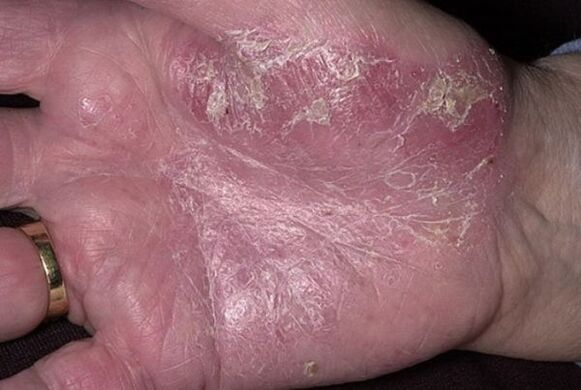
The terminal film is the last layer removed from the skin. Posterior scraping leads to the last stage of the triad - bleeding by dripping.
In this phase, baths of medicinal herbs, drugs with antiallergic effect, ointments of natural base (without corticosteroids and hormones) are used.
Detect bleeding
After the removal of the terminal film, bleeding by dripping occurs in the affected area of the skin (symptom of auspices or "bloody dew") and there is an accelerated growth of neoplasms, which sometimes reach the size of a pea and are called lenticulars. In some cases, the papules grow to the diameter of a small coin and differentiate themselves as numbular. As the disease progresses, its growth increases and, when combined, psoriatic plaques are formed.
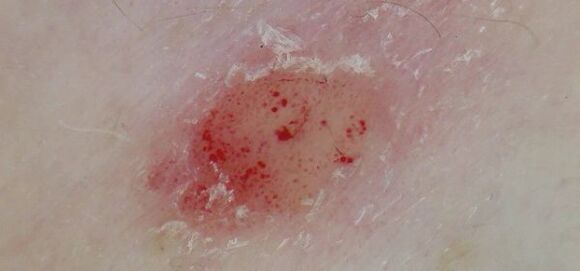
For the treatment, retinoids, immunomodulators, anti-inflammatories, physiotherapy are used.
Others
The disease can be recognized by other characteristic signs, the main of which are 4:
- The border is red, not covered with scales, which form around the papules.
- In a clean area of the skin, small rashes are visible (usually appear before the progressive stage of psoriasis).
- A symptom that helps to distinguish psoriasis from seborrheic dermatitis is characteristic of the active stage of the pathology. It is accompanied by the appearance of papules with clear contours on the scalp, which does not happen with seborrheic dermatitis.
- A border of clear, shiny skin appears around the formation. The symptom is typical of the regression stage of the disease and appears when the papules disappear.

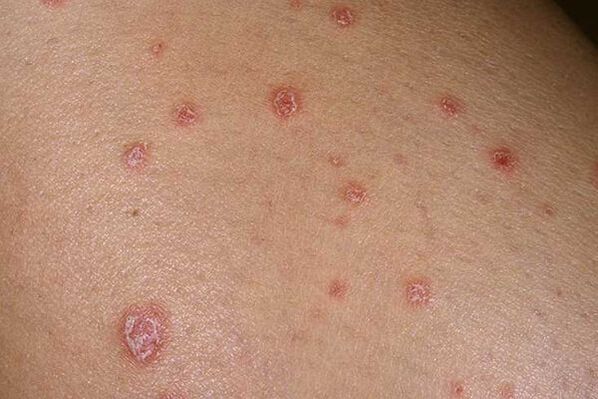

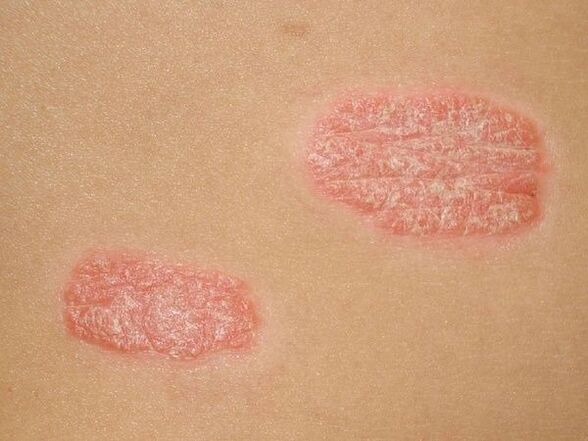
What it looks like
In most cases, the appearance of the pathology is imperceptible: in an initial stage, psoriasis affects small areas of the skin, mainly in the folds of the limbs, head and along the hairline.
Heads up!The initial manifestations occur at the site of constant mechanical irritation of the skin, for example, where the clothing rubs and presses.
Common symptoms:
- itch;
- excessive dryness of the skin;
- peeling of pathological elements;
- general deterioration of health (weakness, lethargy, fever).
There are 3 stages of development of pathological papules:
- Progressive.The appearance of a rash of a bright pink hue, surrounded by a rich and slightly vague border. In the center of the papules, the skin peels off, giving the formations a white color. At this stage, the rash can appear at the site of scratches, skin lesions, bites, cuts, punctures or burns.
- Stationary.It starts 1 to 4 weeks after the onset of the disease. New plates do not appear, the old ones acquire a light color, the intensity of the peeling decreases.
- Regressive.The color of the plaques and papules disappears, their infiltration decreases and the formations dissolve. The average duration of the decomposition period is 2 to 6 to 8 months.
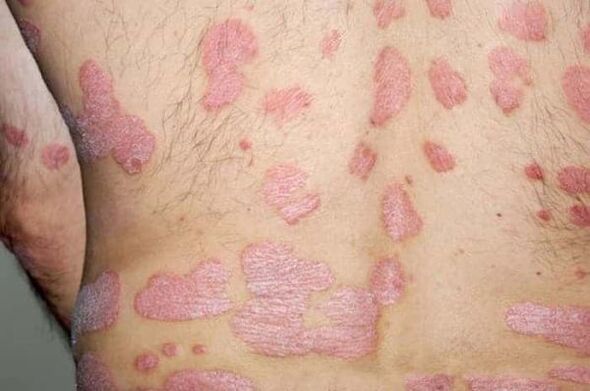
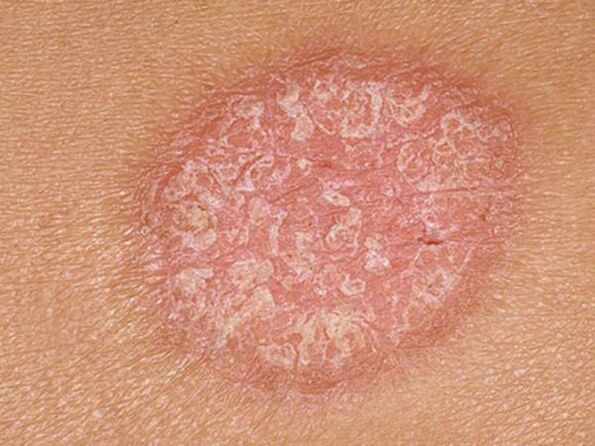

Symptoms of the disease depending on the types:
- Plate(common or common). The most common type of pathology. In various parts of the body (most often on the elbows, knees, head), oval or round plaques of red hue appear, covered with silvery-white scales at the top.
- Seborrheic.It occurs mainly on the scalp. It manifests as flaking and itching, spreading in the area behind the ears and on the skin along the hairline.
- Pustularthe type is considered the most severe form, develops quickly and reaches large areas of the skin. Painful skin rashes appear on the body, which are accompanied by a local rise in temperature, weakness, headache, diarrhea. Vesicles filled with exudate soon form in the lesions. In the future, the spots progress, they merge, forming large lesions on the body.
- Intertriginous.Typical for children, accompanied by the appearance of bright red, slightly flaking papules (may not be there).
- Exudative.The affected areas of the skin not only peel off, but also become moist, yellowish crusts form on the surface of the plaques.
- Psoriatic erythroderma.Red plates with silvery, yellow or white scales are seen throughout the body. It is accompanied by an increase in lymph nodes, an increase in body temperature. In the future, the formations fuse into large spots that cause irritation and itching.
- Psoriatic arthritis.It is accompanied by "joint syndrome", in which the skin in the area of the joints (on the wrists, phalanges of the fingers, spine and so on) is affected and if measures are not taken in a timely manner, the disease affects the joints.
- Teardropaccompanied by profuse skin rashes, consisting of many small plaques. In this case, the papules are in the form of drops, their color ranges from bright red to purple.
- To point.It is characterized by the formation of small spots in various areas of the body, similar to dots, and there may be no flaking of the dermis.
- Rupioid.One of the types of chronic psoriasis. In the formations, crusts appear, become taller, assuming the shape of a cone.
- Oldit manifests in large papules that do not last for long, sometimes papillomas and warts form on them.
- Psoriatic onychialeads to deformation of the nails, the appearance of yellow-brown spots under them.
- Palmar-plantar.Appears on the palms and soles. The main symptoms are thickening of the skin, dryness, fissures.
- Psoriasis of the mucous membranesaffects the oral cavity and causes plaque to appear on the mucous membrane.

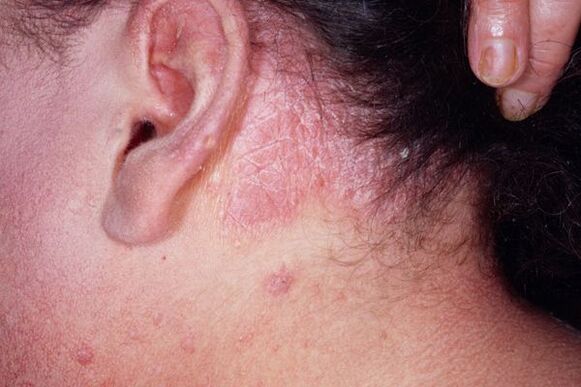
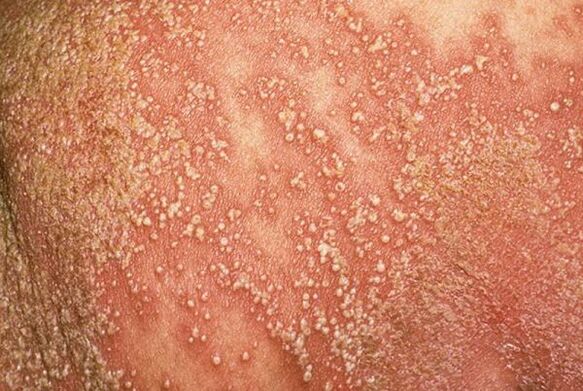
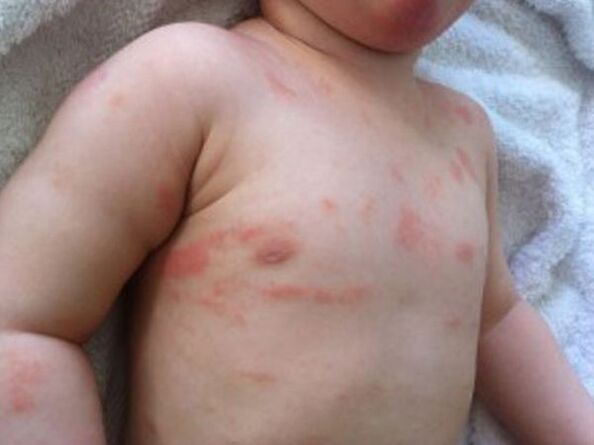



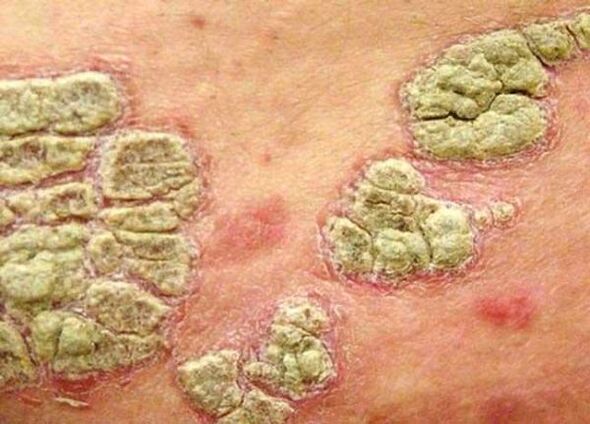
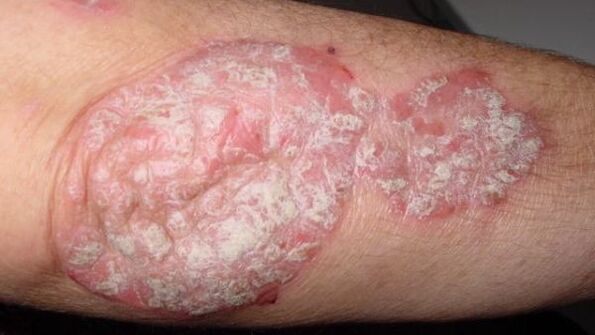


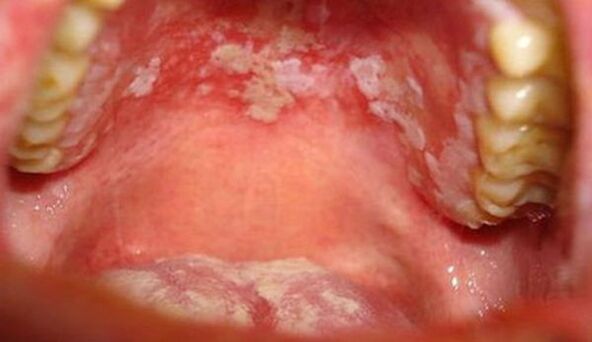
Location of psoriasis
Hands
In most cases, rashes appear on the surface of the elbows or between the toes. Less commonly, papules are seen on the forearm.
Heads up!The hands are characterized by a pathology in the form of a plaque, but others are also found. Its sign is small patches of a red hue, quickly covered by white scales, the affected skin becomes thicker.
Legs
Psoriatic formations occur mainly in the legs, in the knee region, but it is possible that they form in other parts of the legs.
The first rash is unique and small with a clear outline, but loose, inflamed and strongly scaly. These point papules spread quickly to form clusters.
Head
It often develops in the context of seborrhea, affects the hairline, forming the so-called psoriatic crown. Skin formations gradually grow and spread over the entire surface, resembling dandruff. This localization occurs quite frequently, less frequently a rash appears on the ears or behind them.
Nails
The nail plate can be affected by the type:
- Thimble- punctual form of psoriasis. Small lumps appear on the nails, which resemble needle-stick marks.
- Onychomycosis- the nail changes color, becomes opaque, thickens noticeably and begins to peel. Through the plaque, a psoriatic papule is visible, surrounded by a reddish border, similar to an oil stain.
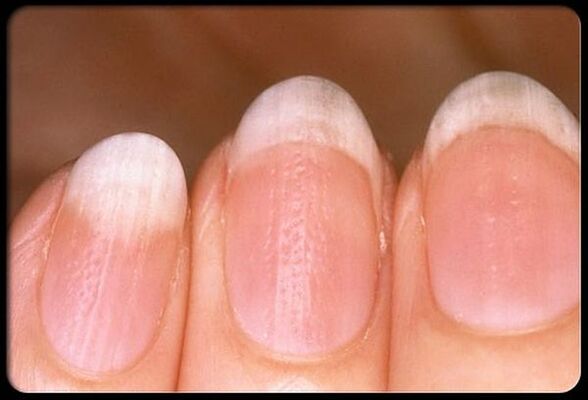
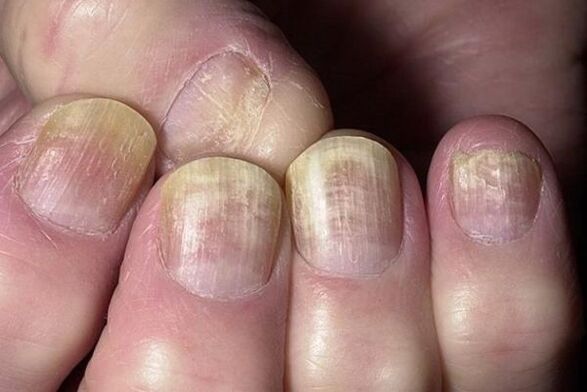
Body
It usually manifests as characteristic fused papules. Psoriasis is more common in the back, less often in the neck, abdomen, hips, the formations can be in the form of a drop, tip and plaque.
Face
It is rarely affected, the rash is located in the nasolabial folds, in the region of the temples and eyebrows, around the eyes. Rarely, the pathology affects the edge of the lips, the rash resembles herpes.
Palms and feet
Both areas are affected simultaneously, but there have been cases where the pathology has developed only on the feet or the palms of the hands. In the soles of the feet, the disease is usually associated with fungal pathologies, which greatly complicates diagnosis and therapy.
This type of psoriasis is divided into 3 types:
- Papular plaque- the formations are dense, do not protrude above the skin, it is difficult to separate the scales from the plaque. The rash occurs in the marginal areas, accompanied by edema and keratosis.
- Psoriatic callus- round and dense papules, consisting of keratinized epidermis. The skin layer thickens and gradually thickens. As a result, it is easily injured, cracks appear. There is practically no redness, the size of the growths is 2-3 millimeters to 2-3 centimeters.
- Vesiculopustular- manifests itself in the form of serous-purulent papules. The bubbles reach 2 millimeters in diameter and tend to stick together.
Gaskets
The pathology can affect a person's joints, which leads to a change in the structure of their tissues, which, with progression, causes pain and deformation. External symptoms: a red rash appears on the skin. Internal signs - pain in the joints, especially during sleep, stiffness of movement, feeling of swelling.
Important!First, psoriasis affects the small joints of the feet and hands, then it spreads to the knee and elbow and, in an advanced stage, the intervertebral joints already suffer.
Itchy or not
In most cases, psoriatic disease is accompanied by itching of varying degrees of intensity, sometimes not just in spots, but throughout the body. In the initial stage, the itching is mild, gradually increasing.
The degree of intensity also depends on the location of the pathology. For example, psoriasis on the head itches a lot, while the skin peels and falls into large flakes, larger in size than normal dandruff. In the stationary stage, the itching decreases, usually giving rise to the burning sensation. During remission, all major symptoms are mild.
The itching gets worse with:
- relapse;
- Climate Change;
- general intoxication;
- digestive tract diseases;
- scab adherence, allergies;
- HIV infections.
The skin itches a lot after drinking coffee, alcoholic beverages, spicy and spicy foods, chocolate and other allergens.
How to distinguish
For eczema
- The nature of the eruption.In eczema, blisters or blisters are filled with a fluid that drains periodically. Psoriasis is characterized by the appearance of dry scaly papules, when removed, blood appears.
- Itchy skin.From eczema, the body itches more than in psoriatic pathology.
- Color.In psoriasis, the scales have a silvery tint and, in eczema, the affected areas become bright red or scarlet.
- Sore areas.Eczema affects the soft and sensitive areas of the skin, armpits and groin. Psoriasis is characterized by a rash in rough, hard and thick layers of the skin (knees, elbows, head and others).
- The causes of the disease.Psoriasis is often caused by neurogenic factors, and eczema is caused by allergies and malfunctioning of the body.
- Features for rashes on the hands.In psoriasis, pits are formed in the nail plate and eczema is similar to a fungal infection.
For seborrheic dermatitis
The clinical manifestations of diseases are similar, but there are several characteristics by which you can distinguish them:
- in psoriasis, an unhealthy glow of the skin and cracks in blood are characteristic, and this is not seen in seborrheic dermatitis;
- dermatitis, unlike psoriasis, is not accompanied by thickening of the skin and its severe dryness;
- in psoriasis, the scales are silver and the seborrhea is yellow or white;
- seborrheic scales are easily removed, but psoriatic scales are not;
- dermatitis is most often seen in sites of accumulation of sebaceous glands and scaly disease - throughout the body;
- scalp psoriasis protrudes visibly beyond the area of hair growth and seborrheic pathology does not cross this line;
- the area of the lesion with scaly lichen is much larger than that of dermatitis.
Fungus
- Psoriasis appears in the presence of several provocative factors, for example, heredity, mechanical damage to the skin, malfunctioning of the immune system and so on. The causative agent of the second disease is only parasitic fungal spores.
- Psoriatic pathology is not contagious, it is not transmitted by airborne droplets, either sexually, or by touch.
Heads up!The fungus (onychomycosis) affects any contact, including in public places - a sauna, a swimming pool, gyms and so on. It is transmitted by animals and people.
- In psoriasis of the head, the structure of the hair does not change, while the fungal disease leads to fragility, dryness and hair loss.
- Unlike scaly lichen, onychomycosis of the legs and feet is accompanied by an unpleasant odor.
- With the defeat of the scaly nails, their structure changes already in the initial stage, and with a fungus for a long time, the structure and color of the nail plates do not change.
Of pink lichen
The hallmark of psoriasis is the "psoriatic triad". The disease grows gradually and goes through 3 stages. Pink pityriasis (pityriasis) develops rapidly and progresses constantly. In addition, pityriasis is a contagious disease, but scaly lichen is not.
From neurodermatitis
- Atopic dermatitis (neurodermatitis) is of allergic origin and is triggered by a certain substance, for example, plant pollen, food, animal hair and so on. The causes of psoriasis are different (heredity, reduced immunity, psychosomatic, mechanical damage to the skin and so on).
- In neurodermatitis, the skin becomes dry and rough, and in psoriasis it becomes scaly and bleeds.
- The dermatitis plaques consist of small separate elements, in the case of the tiles, the papules are uniform and covered with silver scales.
- The color of the rash in psoriasis is much lighter than in neurodermatitis.
For drop
The difference between gouty arthritis and psoriatic arthritis lies in the cause of development. Gout occurs when uric acid crystals are deposited in the cartilage of the joints. Deviation from the norm can be caused by: hypertension, obesity, use of diuretics, alcohol consumption, etc.
The symptoms of psoriasis and gout are similar - severe pain at night, stiff movement, redness and swelling in the affected area. However, in psoriasis, in most cases, the characteristic red rashes appear first and then the pain.
Other characteristic symptoms of gouty arthritis include:
- the presence of white nodules in the area of the affected joint;
- signs of kidney stones (back pain, blood in the urine and others).























